A Beginner's Guide to Memory Training: The Images Discipline
Introduction
In the history of the art of memory, rhetoricians often encouraged their students to train their memory through various drills and mental exercises. As an athlete would train their body for physical activity, one can also train their memory for intellectual activity. I am reminded of Ivan Illich’s commentary on memory training in the medieval period,
“The rhetorical virtuoso was henceforth the one who could mentally register and label each sentence he intended to use, and promptly recover it from the appropriate architectonic feature in his own inner topology…such memory training was part of the equipment expected by Hugh [of St. Victor] from the beginner.”
In my previous posts, I explained how to use the memory palace and the link method, and now I would like to discuss memory training. I usually recommend beginners to first train in the Images discipline for practicing the art of linking and the memory palace since this discipline already provides you with images. In this training, you will develop fundamental skills such as being able to mentally navigate loci, encode information, link images, and to trust in your intuition.
You do not need to be an aspiring competitive memory athlete or professional mnemonist to train your memory. If you want to memorize Scripture, poetry, speeches, or your favorite quotations, memory training can be beneficial to you. Significant progress can be made with just 15 minutes of training a day. I have found that through consistent training, I am able to memorize texts more easily and to concentrate for long periods of time without being distracted.
Memory Training Software
The memory training software that world-class memory experts use is a website called Memory League. It is specifically designed to train one’s use of mnemonic technique through various disciplines such as Numbers, Words, Images, Cards, and Names and Faces.
The Images Discipline
The Images Discipline is perfect for practicing the memory palace technique. In this discipline you are given random images to memorize in 60 seconds. The amount of images presented to you is determined by your level in the memory training software. But, before explaining how to memorize images, I would like you to first familiarize yourself with the website, preferences, and rules by following the steps below:
Visit the Memory League website here, create an account, and select “Train” from the menu after signing up.
Click on “Images” under the Solo Training section.
Select “Preferences” and make sure that the “Groups” are set to 2. This means that two images will be displayed at a time instead of one. Most memory athletes prefer this group setting, however, some prefer to have it set to 1.
Select “Instructions” and read the aim, scoring, memorization, and recall explanations. I will later provide examples of how recall works later in order to make these instructions even more clear.
Select “Level Explanations” at the upper-right hand corner and read how to reach the next level. There are 10 levels in the Images Discipline. As a beginner, you start at level 1 with 6 random images to memorize in 60 seconds, but your goal is to ultimately reach level 10 and to memorize 30 images in 60 seconds or less. I will provide a recommended training schedule at the end of this post so you may reasonably accomplish this goal.
If you are able to and willing to commit time to memory training, sign up for the yearly subscription for $25 a year. After you use the training software for a certain period of time, it should display a prompt messages with instructions on how to subscribe. If you have any difficulty signing up, please email me at: RonaldMJohnsonJr@gmail.com and I can assist with any questions you may have.
A Guide to Memorizing Images
So, now that I provided an introduction to Images Discipline, explained the instructions, preferences, and different levels, I will now explain how to train and memorize random images.
Create a memory palace with 13 loci and mentally walk through the locations forwards and backwards until you are able to confidently navigating the loci. Only proceed to step two, if you are able to move through all 13 loci with ease and without accidently skipping over one. This step is important to follow because you can only memorize as fast as you can move from one locus to next.
Select the “Images” discipline in the “Solo Training” section of Memory League.
Select “Start.”
Memorization will start in 10 seconds. During this time mentally prepare yourself by removing any distracting thought and imagine yourself standing in front of the 1st locus of your memory palace.
Memorize the random images. At level 1, 6 images will be presented to you in groups of two. Memorize them by placing two images per locus. So, images 1 and 2 should be encoded at locus 1, images 3 and 4 should be encoded at locus 2, and image 5 and 6 should be encoded at locus 3. You can move to the next group of images by selecting the blue arrow. By way of reminder, let us review how to encode information at loci. I will give you one example so you can observe how I think and you can practice the technique yourself in the Images Discipline.
How to Encode Two Images Per Locus
So, let us imagine that your first locus in your memory palace is a front door and you are presented with two images, namely, a man and a set of red candles. In order to encode these two images at the locus you have to do at least the following: 1) visualize the images, 2) link them with proper directionality, 3) incoporate movement, and 4) have the images interact with the locus.
Visualize the Images at the Locus
Some have argued that the art of memory is the art of visualization. Memory training is the conditioning of your mental eye. So, visualize the images presented before you and try to see them at your locus as if you were watching a film in your mind. You should see the fine details, various colors, and sense the weight and height of the man. You should see the redness of the candles, the flickering flames, and sense their texture, shape, and lightness.
Link with Proper Directionality
Link the first image to the second image. So, perhaps you can imagine the man in the image blowing the fire from the red candles onto the front door. Notice the order of action: man —> set of red candles, and not set of candles —> man. I would not recommend imagining something like the candle setting the man on fire because during recall you can accidentally swap the order. This could potentially cause doubts, “Was the candle the first image or was it the man?” Using proper directionality is fundamental for ensuring accurate recall.
Incorporate Movement
You should not simply see the images at your locus as photographs. Use action and exaggerated movement. Instead of the man walking, perhaps he could be running at an intense speed. Or perhaps the flame can move like a gust of wind, engulfing the entire door into flames. Or perhaps the man can kick the candle and splatter wax all over the door or the flame can rapidly wave back and forth like a banner in the sky. Remember, since you only have 60 seconds, be sure to use simple actions and not to create elaborate stories.
Interact with the Locus
In most cases, it is not enough to just visualize the images before the loci, they must interact with the locus itself. As mentioned in my previous post on the Link Method, this type of interaction is important because it provides useful contextual clues during recall. There will eventually be a point in your memory training where you will be memorizing images so quickly that perhaps all you remember is “redness.” You may be asking yourself: “Hmm, was it blood? Oh wait, perhaps it was a red balloon? Or no, maybe it was a red flower?” But, if you have the image interact with the locus in some way, such as having the front door on fire with red wax on it, you can infer that the previous image was a set of red candles.
There are many ways to have images interact with loci. You can choose to transform the locus into the last image or animate it to display certain characteristics. For example, let’s imagine that the first locus is a door: if the first image is a dog and the second image is a necklace made of beads, you can imagine a dog jumping into a door made of beads. You can even incorporate sound. If the first image is a paint brush and the second image is a lion. You can imagine yourself painting a door made of fur, and as soon as you press the brush against the door, you can hear a loud and terrifying roar.
Recall Preparation
After the 1 minute of memorization you will be given time to prepare for recall. The time allotted can be adjusted under “Preferences” section to none, 5, 10, or 20 seconds. Some memory athletes use this time to mentally rehearse the imagery in their memory palace before recall. You can choose to skip or take time to review your loci. For now, you can skip, and later you can experiment with both approaches to see what works best for you.
Recalling Images
After the recall preparation time is complete, you will be directed to the recall page. Here you will find empty boxes that need to be filled with images and a set of shuffled images at the bottom. Boxes 1 and 2 are for images 1 and 2 that you memorized at locus 1, boxes 3 and 4 are for images 2 and 4 that you memorized at locus 2, and so on. Select a box that you would like to insert an image, and then click on the correct image at the bottom in order to place it in the yellow box. You will have 4 minutes to put all the images in order.
During recall you want to imagine yourself at the various locations of your memory palace and see the imagery that you created with your mental eye. If you are unable to recall the exact images, and are unsure about which image to select, move back and forth between the loci. Sometimes simply walking to the next locus and then moving back to the previous locus helps our recollection. Listen to your intuition, if you do not recall the image, perhaps you can remember a feeling, or the sense of a human presence opposed to an inanimate object. Also think about all the contextual clues and the impressions made upon the loci.
Review the Results
Once the recall time is over, you will be given your results. A green box signifies that you recalled the order of the image correctly, and a red box signifies that you recalled it incorrectly. If you happen to have any errors, review them and ask yourself, “Why did I forget this image? What made it so difficult to remember? Why did I swap the order?” Perhaps, you needed to create stronger links, or interact better with the loci, or add more movement to the images.
Homework
The homework for this week is to follow the recommended memory training schedule below. Read this article again and put into practice the memory techniques explained. Each exercise should take 15 minutes or less to complete.
Recommended Memory Training Schedule for Beginners
Day 1: Images Discipline - 1 attempt (use memory palace #1)
Day 2: Create another memory palace with 13 locations and review the loci.
Day 3: Images Discipline - 1 attempt (use memory palace #2)
Day 4: Images Discipline - 1 attempt (use memory palace #1)
Day 5: Review memory palaces 1 and 2 by walking through all 26 locations in your mind. Say each locus aloud on a voice recording app or write them on a sheet of paper to quiz yourself.
Days 6 and 7: Rest
The Memory Palace Technique Series
If you are new to the Craft of Memory and would like to read the memory palace technique lessons in order, you can click on the following links: (Lesson 1, Lesson 2, Lesson 3). Note: each lesson includes a homework assignment.
Benefits of Becoming a Paid Subscriber
Receive access to all memory lessons and articles on the history of mnemonics.
Exclusive interviews from memory experts and world-class memory athletes.
Receive access to all recommended memory training schedules, exercises, and homework assignments.
Support the Craft of Memory
If you have been enjoying my lessons on the art of memory, please consider supporting in the following ways:
Like and/or leave a comment
Restack this post with or without a note
Share this post with someone you think may be interested in mnemonics
Recommend the Craft of Memory
Conversation:
As of 8/30/23, my personal best in the Images Discipline is 30 images in 23 seconds. As the series progresses, I will provide detailed memory training schedules and techniques to help increase your speed and accuracy.


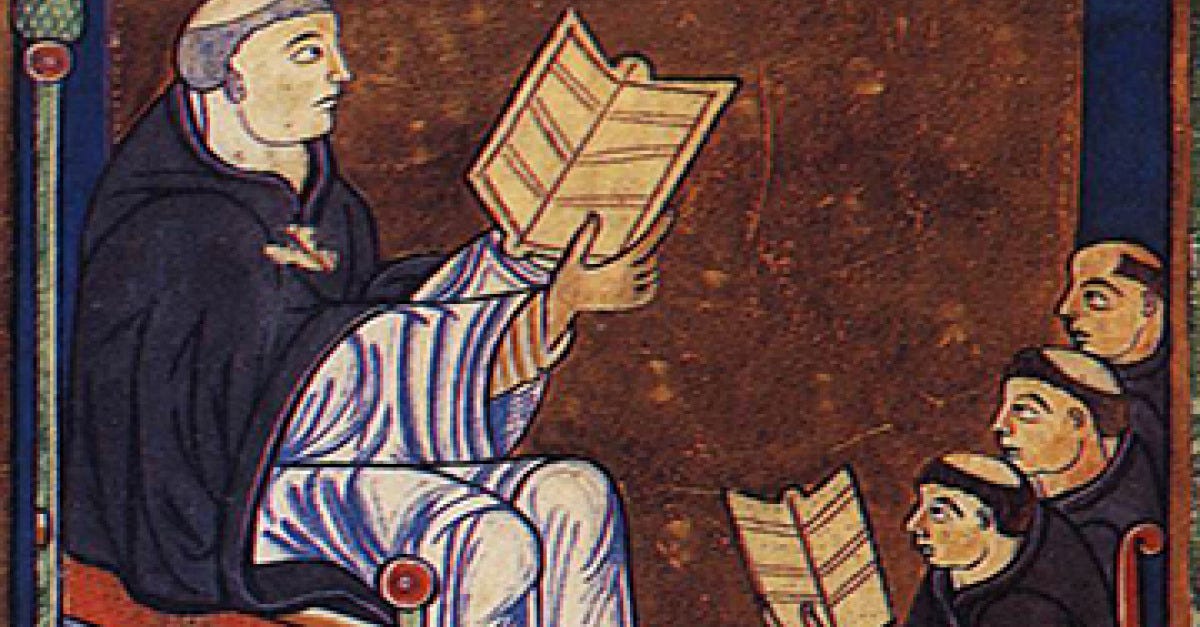
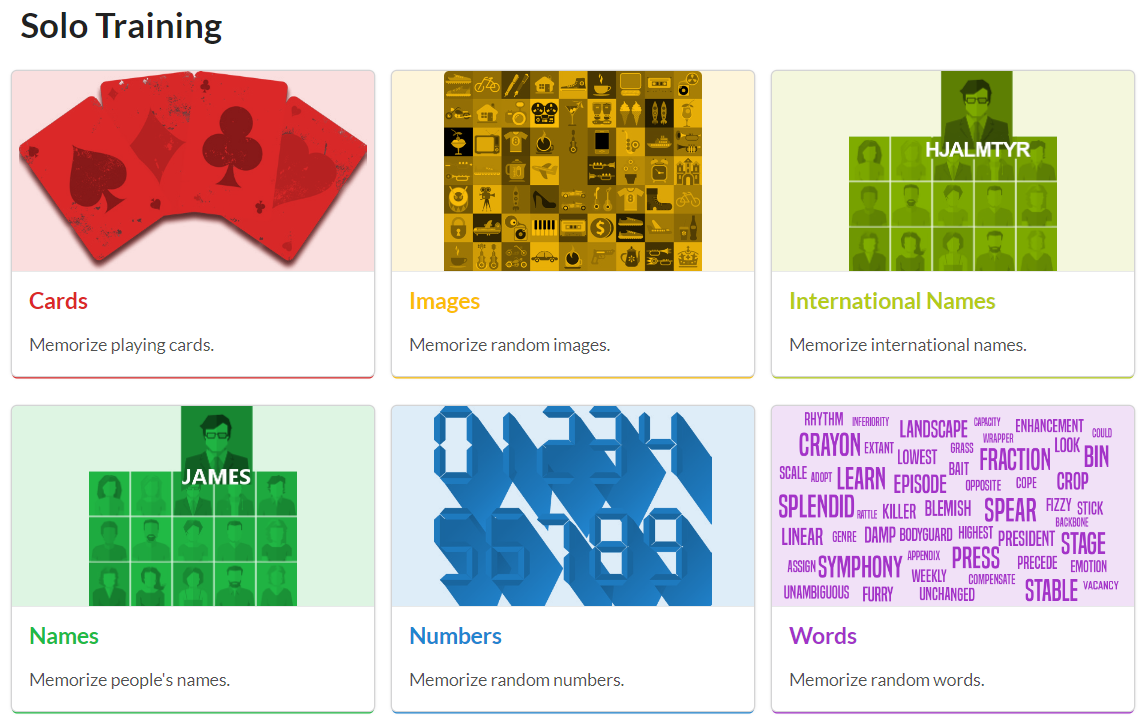


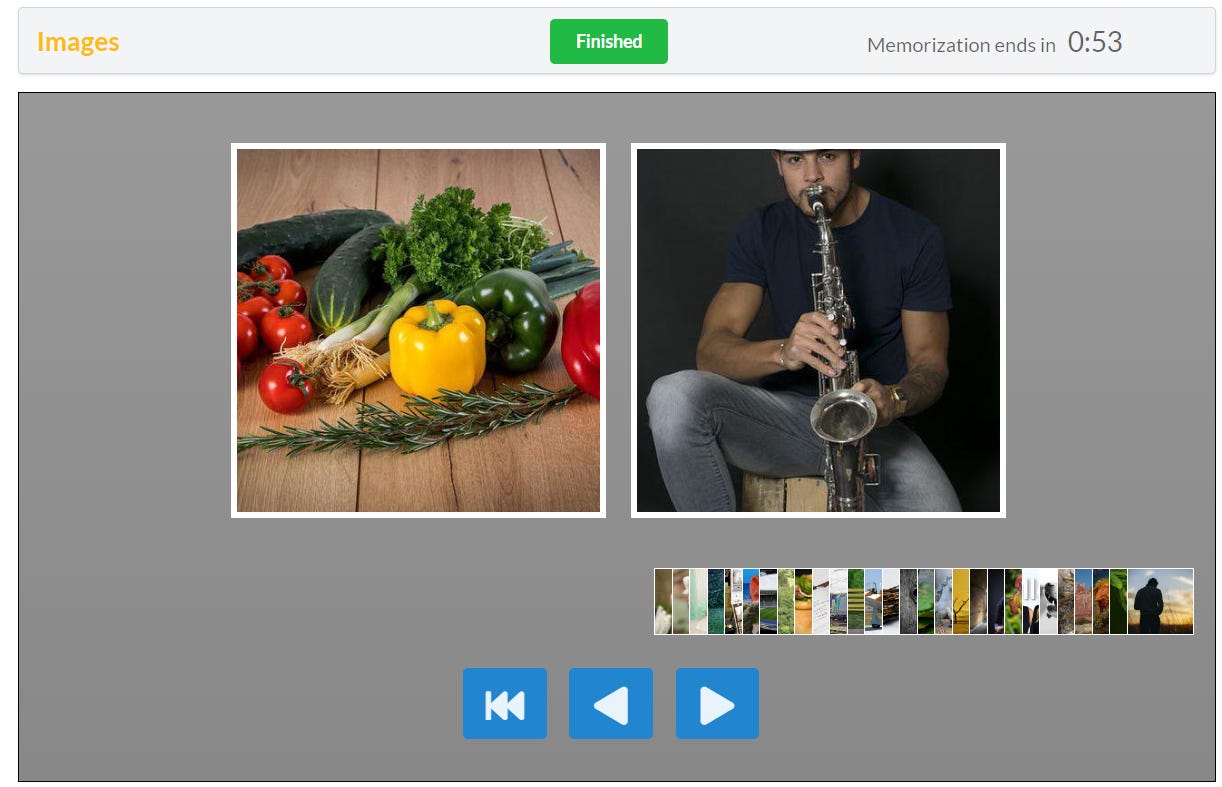


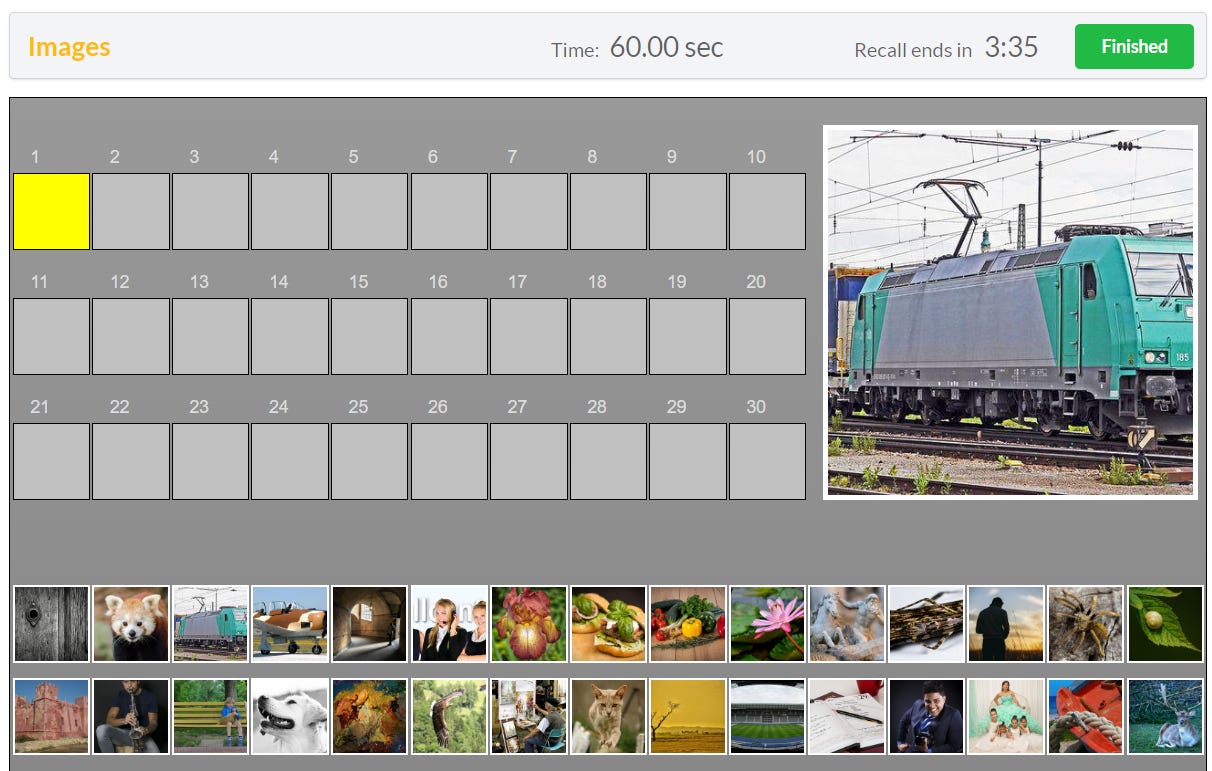
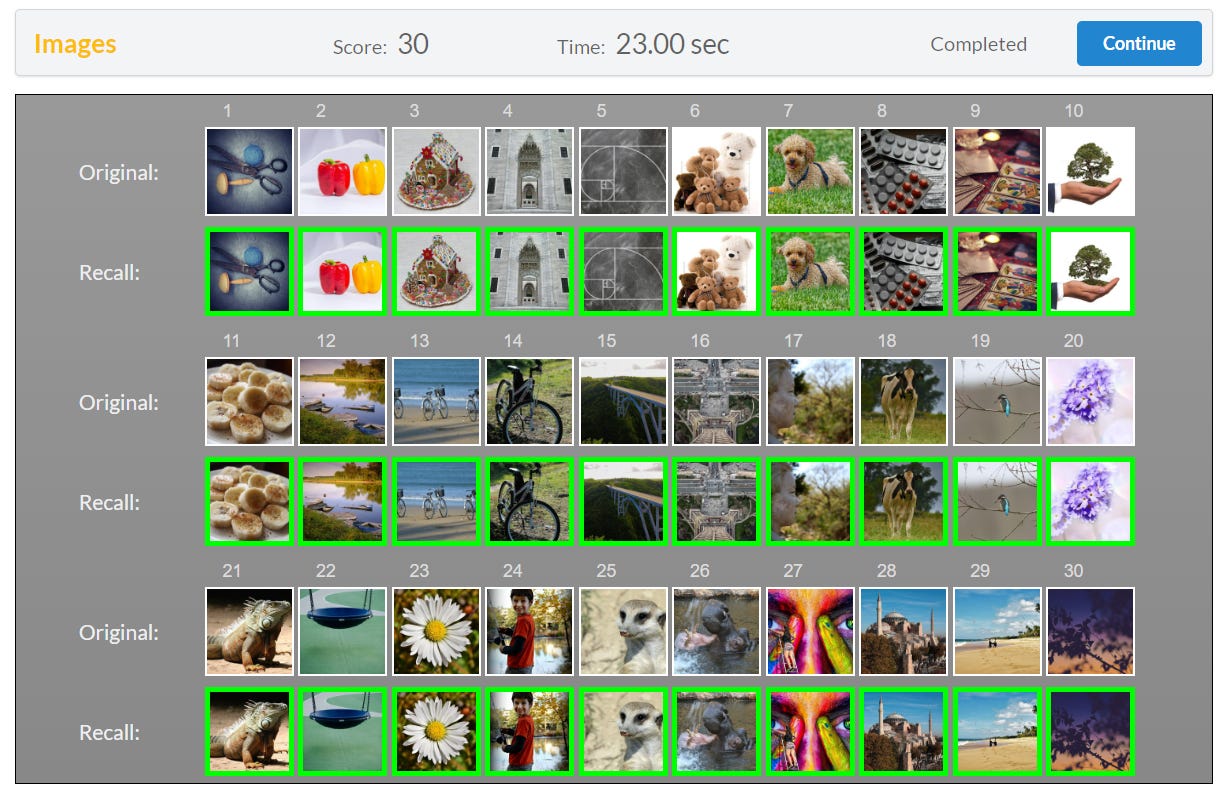
Dear Memory Guy,
This such great stuff and vital to anyone who aspires to "write." Me, I just type for the moment. I am in the process of de-lawyering my rhetorical self. Time to re-visit the canons of rhetoric, of which memoria is the most useful. Your substack has arrived at the right place at the right time.
Thanks, and don't stop.
Superb - just tried the image version on the site you linked with my son and will make memory part of our school routine. Thanks so much for your detailed and helpful work!